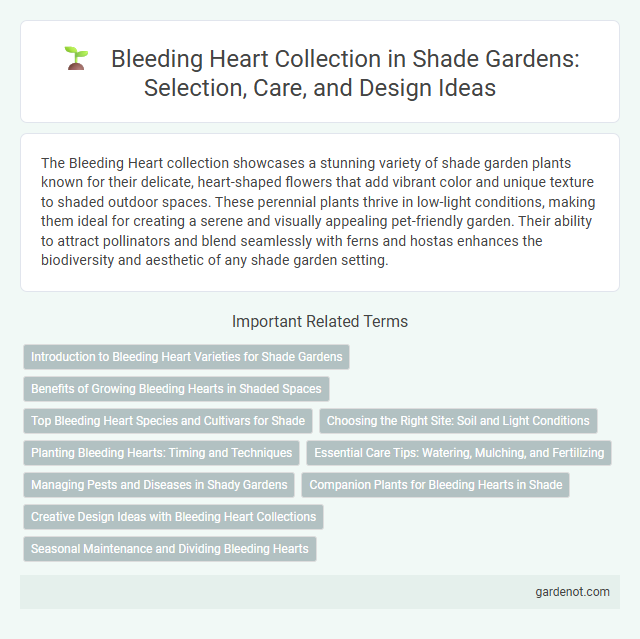The Bleeding Heart collection showcases a stunning variety of shade garden plants known for their delicate, heart-shaped flowers that add vibrant color and unique texture to shaded outdoor spaces. These perennial plants thrive in low-light conditions, making them ideal for creating a serene and visually appealing pet-friendly garden. Their ability to attract pollinators and blend seamlessly with ferns and hostas enhances the biodiversity and aesthetic of any shade garden setting.
Introduction to Bleeding Heart Varieties for Shade Gardens
Bleeding heart varieties such as Dicentra spectabilis, Dicentra eximia, and Dicentra formosa offer unique heart-shaped flowers ideal for shade gardens. These perennial plants thrive in partial to full shade, providing vibrant pink, white, or coral blossoms from spring to early summer. Their fern-like foliage and graceful arching stems enhance the texture and color diversity in shaded garden beds.
Benefits of Growing Bleeding Hearts in Shaded Spaces
Bleeding hearts thrive in shaded gardens, offering vibrant pink and white heart-shaped flowers that brighten low-light areas. Their ability to grow well in moist, well-drained soil helps prevent erosion and supports local pollinators like bees and hummingbirds. These perennial plants enhance garden biodiversity and provide seasonal interest from spring to early summer.
Top Bleeding Heart Species and Cultivars for Shade
Top bleeding heart species and cultivars for shade gardens include Dicentra spectabilis, known for its classic pink, heart-shaped flowers, and Dicentra eximia, prized for its extended bloom period and compact size. The cultivar 'Luxuriant' offers vibrant pink blossoms with enhanced durability, while 'King of Hearts' displays larger, deeply lobed foliage and rich blossoms ideal for moist, shaded environments. These selections thrive in well-drained, humus-rich soil and provide striking early to mid-spring color under tree canopies or in woodland beds.
Choosing the Right Site: Soil and Light Conditions
Bleeding heart (Dicentra spectabilis) thrives best in well-drained, rich, and slightly acidic soil with consistent moisture to prevent root rot. Ideal planting sites are shaded or receive filtered sunlight to protect the delicate, fern-like foliage from harsh afternoon sun. Selecting a location with dappled shade ensures optimal bloom production while maintaining the plant's overall health in a shade garden environment.
Planting Bleeding Hearts: Timing and Techniques
Plant bleeding hearts in early spring after the last frost to ensure optimal growth and bloom. Choose a shaded or partially shaded location with well-draining, rich soil to mimic their natural woodland habitat. Space plants 1 to 2 feet apart and water consistently to maintain moist soil, promoting healthy roots and vibrant flowers.
Essential Care Tips: Watering, Mulching, and Fertilizing
Bleeding heart plants thrive in consistently moist, well-drained soil, requiring regular watering to prevent drying out, especially during hot, dry spells. Apply a 2-3 inch layer of organic mulch around the base to maintain soil moisture, regulate temperature, and suppress weeds. Fertilize in early spring with a balanced, slow-release fertilizer to support healthy growth and vibrant blooms throughout the growing season.
Managing Pests and Diseases in Shady Gardens
Effective management of pests and diseases in bleeding heart collections (Dicentra spectabilis) within shade gardens involves regular monitoring for common issues like aphids, slugs, and powdery mildew. Implementing integrated pest management (IPM) practices, including natural predators such as ladybugs and applying neem oil or insecticidal soaps, helps maintain healthy plants without chemical overuse. Ensuring proper air circulation, avoiding overhead watering, and removing diseased foliage reduce fungal infections and promote vigorous bleeding heart growth in low-light environments.
Companion Plants for Bleeding Hearts in Shade
Companion plants for Bleeding Hearts thrive in similar shady, moist conditions and include hostas, ferns, and astilbes, which enhance the garden's texture and color contrast. These shade-loving perennials provide a lush backdrop that highlights the delicate, heart-shaped blooms of Dicentra species, while also improving soil moisture retention. Integrating Solomon's seal and coral bells further supports biodiversity and attracts pollinators, creating a balanced shade garden ecosystem.
Creative Design Ideas with Bleeding Heart Collections
Bleeding heart collections add a whimsical charm to shade gardens with their delicate, heart-shaped blooms in shades of pink, white, and red. Creative design ideas include pairing these perennials with ferns and hostas to enhance texture contrast and create a lush, layered look. Incorporating bleeding hearts along shaded pathways or near water features amplifies their visual impact and fosters serene garden retreats.
Seasonal Maintenance and Dividing Bleeding Hearts
Bleeding heart plants require regular seasonal maintenance, including cutting back foliage after blooming to promote healthy growth and prevent disease. Dividing bleeding hearts every 3 to 4 years in early spring or late fall helps rejuvenate the plants, ensuring vibrant blooms and robust root systems. Proper division involves carefully separating rhizomes with at least one growth bud, then replanting them in well-drained, shaded soil for optimal growth.
Bleeding heart collection Infographic

 gardenot.com
gardenot.com